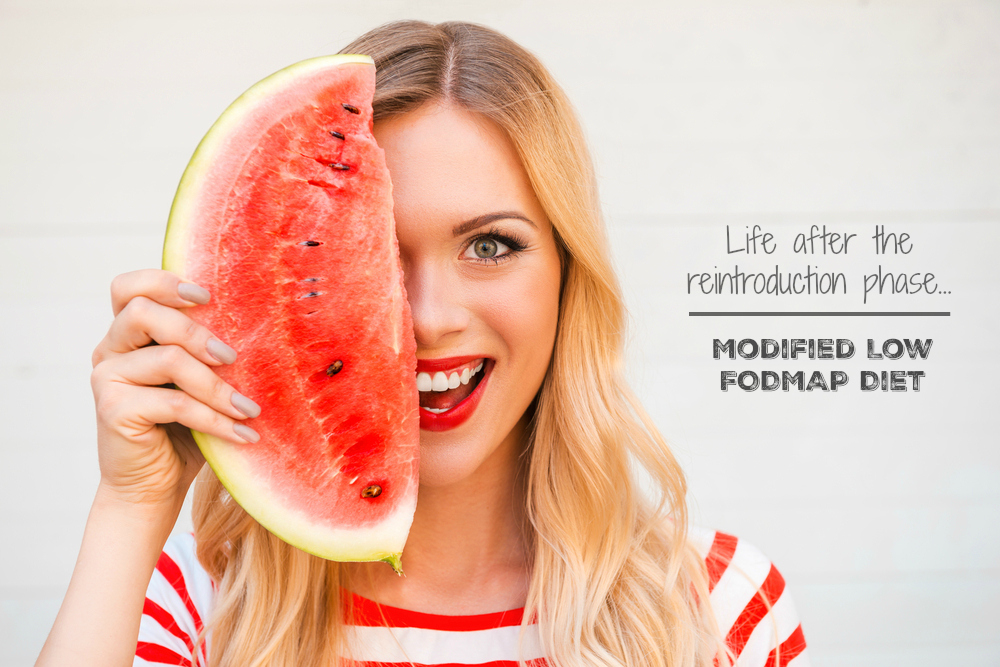So you have finished the low FODMAP phase, and completed your FODMAP reintroduction challenges… what happens next?
The Modified FODMAP Diet
This is the most exciting phase of the FODMAP diet! Now that you have a good understanding of what high FODMAP foods trigger your gastrointestinal symptoms we can tailor the diet to suit your long-term health needs.
The third phase of the FODMAP diet isn’t often discussed in articles or by low FODMAP professionals. The goal of this phase is to keep your symptoms under control while incorporating a range of high FODMAP and low FODMAP foods in your daily diet. Initially, this process can be a bit like walking a tightrope, as you need to discover what high FODMAP food combinations you can eat and how often, before they trigger symptoms. Then you can settle into your new food routine while maintaining good gut health and symptom control.
The modification phase is the final stage of the low FODMAP diet and it is likely you will remain on some version of this phase for life to maintain good symptom control. If possible it is a good idea to work with a dietitian during the initial part of this phase. Your dietitian can make sure your long-term diet is nutritionally balanced and that you are getting enough fibre and prebiotic foods.
How is figuring out my version of the modified low FODMAP diet different to the reintroduction phase?
The Reintroduction Phase
During the reintroduction phase you focus on testing challenge foods that only contain one FODMAP group. This is so we can discover if you have a tolerance level for that particular FODMAP. For example, when you use mango to challenge excess fructose we are looking to see if you can tolerate a small, medium or large amount of excess fructose before triggering symptoms.
During the reintroduction phase, you might discover you can tolerate a lot of one FODMAP group, a moderate amount of another FODMAP group, and a small amount of a third FODMAP group. Another person might find they can tolerate small amounts of all FODMAP groups with minimal or only mild symptoms. And someone else might find they can only tolerate small amounts of one FODMAP group.
The Modified Low FODMAP Phase
In contrast, the modified low FODMAP diet phase focuses on discovering how often you can have the high FODMAP foods you tolerate, and what happens when you combine them with other FODMAPs. Once you have discovered your perfect balance of high and low FODMAP foods you can remain on the modified low FODMAP diet.
Let’s Look At Some Examples
- What happens when you combine the FODMAP groups you tolerate together over the course of a day? For example, 2 slices of wheat bread for breakfast, 1/4 avocado for lunch and then a small portion of fried Portobello mushrooms in your dinner. Even if you passed the individual FODMAP challenges for these high FODMAP foods, combining them together could still push you over your FODMAP threshold. At the start of the modification phase, you will need to figure out what food combinations you can successfully eat without triggering symptoms.
- If during the reintroduction phase, you discovered you could tolerate small amounts of one FODMAP group, then at the start of the modification phase you need to figure out how often you can have a small serve. For example, if you tolerate the fructans in ¼ clove of garlic, can you have that in your dinner each night? Or do you need to leave a day in between each serve to keep your symptoms settled?
This process does require a bit of trial and error but it is well worth it. Just remember if a food combo goes wrong you can go back to the low FODMAP diet (only eat low FODMAP foods) for a few days until symptoms settle, then continue incorporating high FODMAP foods in your diet. Once you have figured out the frequency and amounts of high FODMAP foods you can combine, then you are good to go! Just remember that everyone’s version of the modified low FODMAP diet will look slightly different, as it is tailored to your needs.
Here are a few tips to help get you started:
- Keep one to two meals per day low FODMAP to begin with
- Then gradually add high FODMAP foods that you tolerated in your reintroduction challenges into your meals. Start with one moderate to high FODMAP food per day and have a rest day in-between.
Are you ready to take control of your gut symptoms?
No thanks, my gut is perfect.
Article continues below
- If that goes well, try having two FODMAP foods in one meal or spread throughout the course of the day. Or alternatively, try having a high FODMAP food each day.
- Continue to try different variations until you are enjoying a range of foods and are comfortable with your symptom levels. If your symptoms progress from mild to severe (where you experience pain or significant discomfort), revert back onto the low FODMAP phase for a few days until symptoms settle. Then continue to modify your diet.
- If possible work with a dietitian during the initial part of this phase. Your dietitian will make sure your modified diet is nutritionally adequate and will help support long-term gut health.
Final Thoughts
The modified low FODMAP diet is the final stage in your FODMAP journey. We hope after a bit of trial and error you can eat with confidence and enjoy a wider variety of foods. If you need information about how to test FODMAP groups, please check out our guide on How To Reintroduce FODMAPs.
Helpful Articles
Just 2-6 weeks, it is not a STRICT diet for life by Monash University
Understanding the 3 Phases of the Low FODMAP Diet by accredited practising dietitian Joanna Baker












Leave a Reply